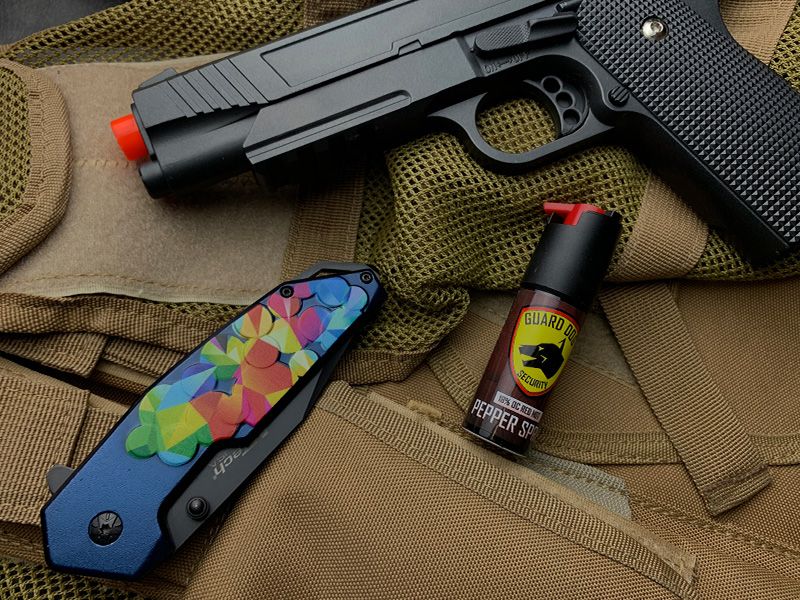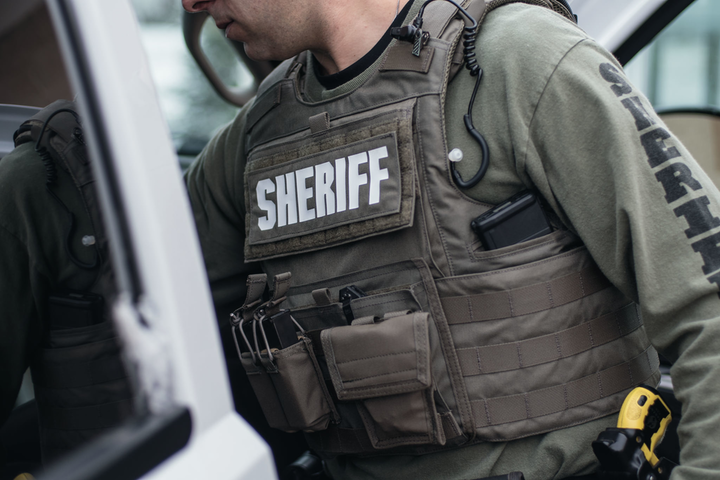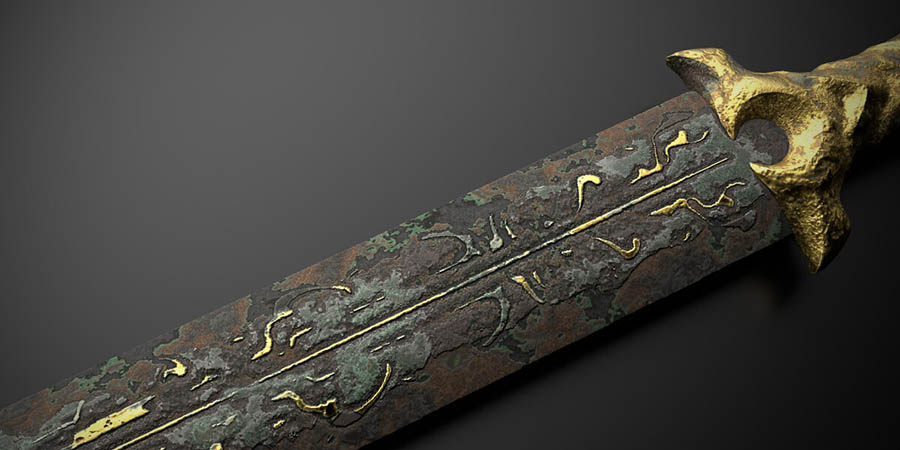Men have been cutting, slashing, and stabbing one another for thousands of years. As soon as people figured out how to shape metal instead of stone or bone, they started turning that knowledge into weapons. The first true swords are believed to have appeared roughly 3,700 years ago, and from that point on, bladed weapons evolved side by side with armor, tactics, and military technology.
Over the centuries, sword designs became more sophisticated and specialized. Some blades were built primarily for stabbing, others for slicing, others for hacking through armor or cavalry charges. As shields, helmets, and body armor improved, smiths had to rethink what a “good” sword looked like. A shield with a big boss might encourage more thrusting attacks around the edges; head-to-toe plate armor pushed designers toward narrow, stiff blades that could probe into gaps rather than trying to cut through steel.
Different cultures solved the same basic problem—how to kill or disable an opponent—as efficiently as possible, but their solutions looked very different. A Roman infantryman, a Japanese samurai, and a 16th-century German mercenary would all have recognized each other’s weapons as swords, yet the way they handled them, the way they carried them, and the role those blades played in their society could be worlds apart. Some weapons were purely practical tools of war; others became symbols of rank, spiritual objects, or heirlooms passed down through families.
From the short stabbing sword that helped Rome dominate the Mediterranean, to the curved sabers of the Middle East, to exotic experimental blades that behave more like whips than swords, the following sixteen handheld weapons are among the most important—and historically deadly—bladed arms ever invented.
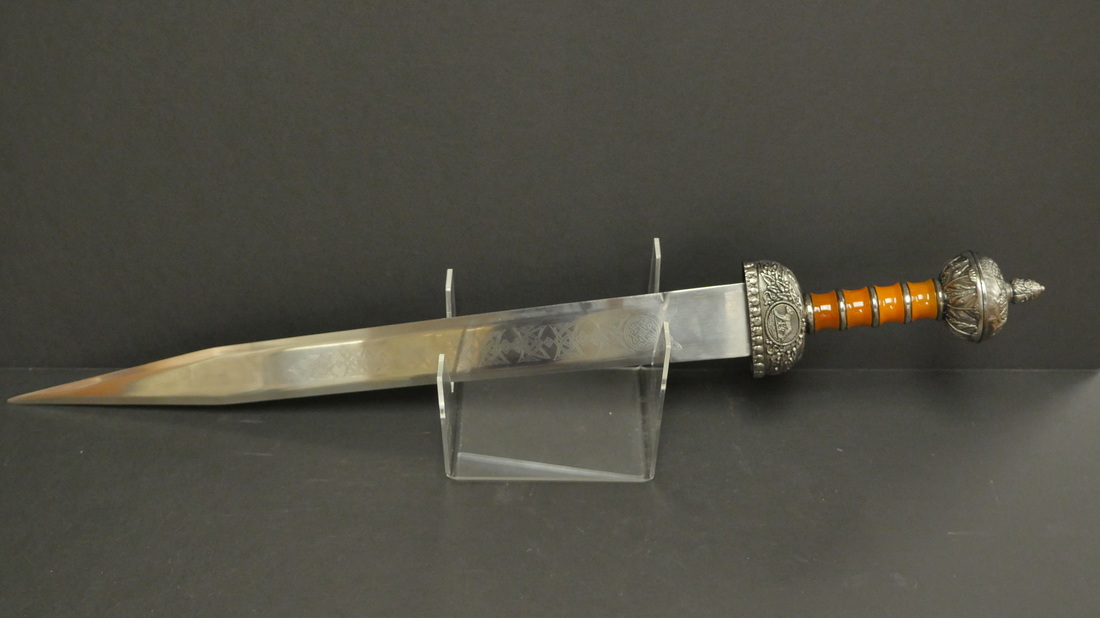
16. The Roman gladius – the short sword that gave us “gladiators” and stabbed Rome’s enemies for 800 years
According to the ancient historians Livy and Polybius, the famous Roman gladius was not originally a Roman creation at all. The early Republic supposedly copied it from the swords carried by Celt or Iberian mercenaries fighting for Rome’s enemies, particularly during the Punic Wars against Hannibal. Roman smiths then refined the design. They forged the blade by laminating and welding strips of low-carbon steel, often leaving a shallow groove down the center. That channel lightened the weapon while adding rigidity, so the blade could withstand the shock of repeated thrusts.
A typical gladius was short and straight, usually around 18–24 inches in length, with a grip sized for just one hand. The handles were often carved wood or bone, capped with a rounded pommel to stop the hand slipping. Decorative details—engraved hilts, inlaid patterns, or inscriptions—were more common on an officer’s weapon, but even rank-and-file soldiers might have a bit of ornamentation if they could afford it. Legionaries tended to wear their gladius on one side of the belt, while centurions wore theirs on the opposite side as a quick visual marker of rank.
Although it could certainly cut and even sever limbs if sharpened well, the gladius was primarily a stabbing sword. Roman infantry tactics were built around that fact. At the start of a battle, legionaries hurled their heavy javelins to disrupt enemy formations and spoil shields. Once contact was made, they advanced in tight ranks, using their large scuta (shields) to shove, knock, and crowd their opponents. From behind the wall of wood and iron, they would shoot their gladius forward in quick, brutal thrusts into the abdomen, chest, or groin.
In an era with almost no effective battlefield medicine, even a shallow puncture to the gut or lower torso was often fatal. Roman soldiers were also trained to exploit any opening they saw: stabbing under a shield to cripple knees, ramming the point into an exposed armpit, or slipping the blade between armor plates. The gladius was not a flashy dueling weapon, but as a mass-issued infantry sword, it was devastatingly efficient—so much so that it remained in frontline use, with variations, for centuries and even lent its name to the arena fighters we now call gladiators.
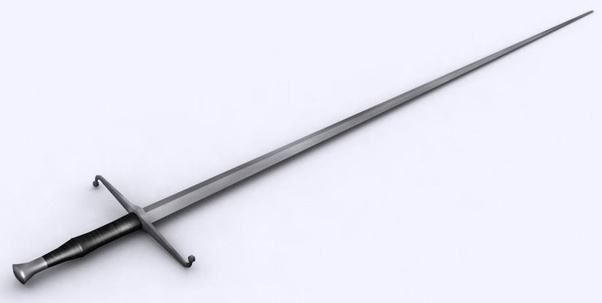
15. The Estoc – a stiff thrusting sword built to punch through mail and armored knights
As armor technology improved in medieval Europe, traditional cutting swords struggled to keep up. Chain mail, padded gambesons, and eventually steel plate made it far harder to simply slice or hack an enemy down. The estoc emerged as a direct response to this problem: a long, narrow, incredibly rigid blade optimized for thrusting straight into the weak points of armor.
Unlike broad cutting swords, the estoc had little or no sharpened edge. The blade was usually triangular, square, or diamond-shaped in cross-section, ending in a tough, needle-like point. Many were long enough to require two hands, with extended grips and large, simple crossguards. This allowed the user to plant both hands and put their entire body weight behind a single thrust, driving the point down toward gaps in a harness of mail or plate. Even if the point didn’t find an opening, the concentrated force could bend rings of mail or dent plate deeply enough to bruise ribs, crack bones, or knock a knight off balance.
On the battlefield, an estoc was often a secondary weapon, carried by men-at-arms, knights, or professional soldiers who expected to face fully armored opponents. In the chaos of a melee, once the initial clash of lances and longer polearms was over, an estoc could be used to follow a tumbling knight to the ground and finish him through the joints in his armor—armpits, visor slits, groin, or the back of the knee. Where the blade could not penetrate, the sheer impact of a committed thrust could still leave an enemy reeling or senseless, ready to be dispatched with a dagger.
The estoc also found other uses. In tournaments, versions with blunted points and rounded edges were sometimes used for controlled thrusting bouts, offering realism without the immediate risk of decapitation. Hunters adopted similar blades for dangerous game such as boar or bear, using the long, rigid point to deliver a fatal strike at close range after the animal had been brought to bay. Risky, yes—but for those who wanted to prove bravery up close instead of at the safe end of a spear, the estoc was the perfect tool.
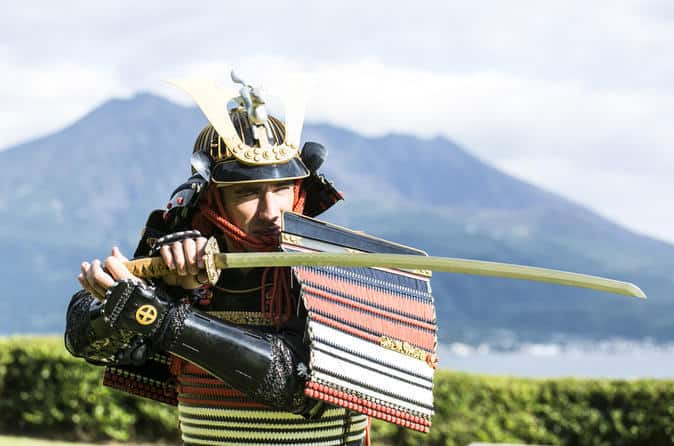
14. The katana – the iconic samurai sword and symbol of status, skill, and strict honor
From around the 12th century onward, warfare in Japan was increasingly fought at close quarters. Armor styles changed, and so did the way warriors fought. In this environment, a sword that could be drawn and used in a single motion could mean the difference between life and death. The katana, with its distinctive curved blade and wearing style, was the elegant answer to that problem.
Unlike straight blades worn hanging vertically from a belt, the katana was typically worn edge-up, tucked through a sash. A practiced samurai could grasp the hilt, draw, and strike in a single fluid motion—an art known as iaijutsu. The curve of the blade helped the sword glide from the scabbard and naturally follow a cutting arc. Over the centuries, exact lengths and curvature changed, but the basic form remained remarkably consistent: a single-edged, slightly curved blade with a long handle for two-handed use and a small circular or squared guard.
For the samurai class, the katana was much more than a piece of equipment. It was a marker of social rank and a physical expression of the warrior’s moral code. Blade and maker’s marks were recorded and cherished; swords were passed down through generations as family treasures. Samurai could own multiple blades—a long katana and a shorter companion sword—but the long sword was seen as the “soul” of its owner, to be drawn with purpose rather than on a whim.
Even as firearms began reshaping warfare, the katana remained in use. Officers in the Imperial Japanese Army carried swords inspired by or directly descended from traditional katana well into the 20th century. Many of these blades were used in brutal close-quarters fighting during the Second World War, especially in jungle terrain and urban assaults where combat collapsed into chaotic, face-to-face struggles.
The katana’s reputation for cutting power is legendary and not entirely undeserved. Traditional smithing methods produced hard, finely honed edges backed by more flexible steel. Combined with the sword’s curve and draw-cut motion, a skilled swordsman could inflict horrific wounds with frightening speed. After Japan’s defeat in 1945, occupying authorities were wary of the weapon’s symbolic and practical power. Sword ownership was heavily restricted, and several martial arts that trained in live-blade usage were temporarily banned. The fact that a single type of sword could stir so much concern centuries after its appearance says a lot about its place among history’s deadliest blades.
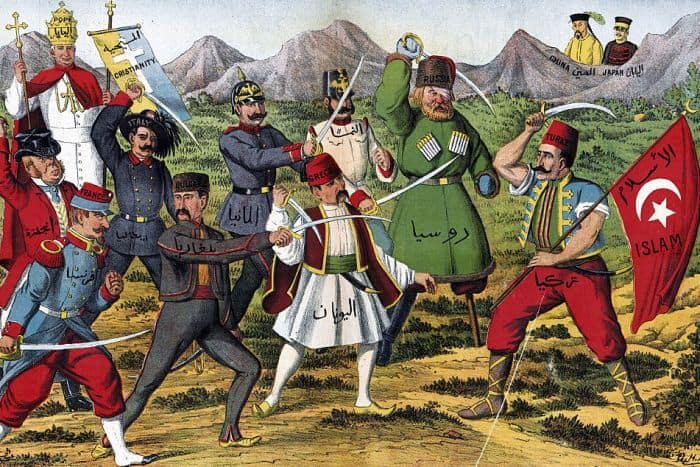
13. The kilij – a viciously effective Turkish saber with a flared, bone-cutting tip
The kilij began life among Turkic peoples of Central Asia, and its name in Turkish simply means “sword.” Over time it became so influential that entire regions—from the Ottoman Empire to parts of Eastern Europe—abandoned older straight blades in favor of this aggressively curved design. The kilij is part of the wider family of sabers, but it has a distinctive personality of its own.
A classic kilij has a moderately curved, single-edged blade that widens and thickens near the tip. This flared section, sometimes double-edged, is called the yalman. The added mass toward the end of the sword turns each swing into a heavy, chopping blow, while the sharpened back edge at the very tip makes it possible to deliver thrusts that bite deeper than a simple curved cutter normally could. Against lightly armored foes—cloth, leather, or simple mail—the kilij could sever limbs or slice deep into bone with a committed slash.
On horseback, this design really came into its own. Cavalrymen could ride past infantry and let the curve and weight of the blade do the work, cutting down from above with minimal effort. The ability to both slash and thrust gave the kilij an edge—literally and figuratively—over some other curved swords such as the ultra-slender Persian shamshir, which excelled as a cutter but was less suited to powerful thrusting attacks.
Beyond the battlefield, the kilij carried a certain swagger. Many Ottoman warriors and officers liked its silhouette, believing the dramatic curve and flared tip gave them an intimidating, almost theatrical presence. As the centuries passed and the empire modernized, military fashion shifted toward European-style straight sabers, especially in the 19th century. The old kilij slowly disappeared from regular service, but its outline still appears in art, heraldry, and modern reproductions, a reminder of a blade feared for both its looks and its lethality.
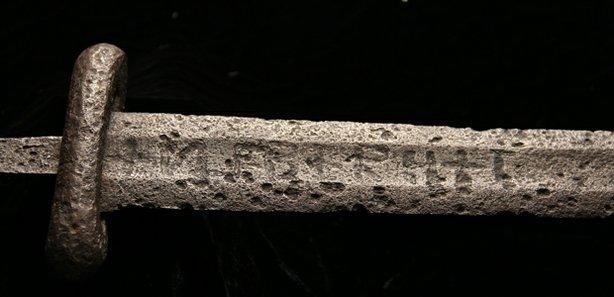
12. The Ulfberht – legendary Viking swords so advanced they seemed almost magical
Luxury weapons are not a modern invention. Over a thousand years ago, Viking elites already knew the value of carrying something special into battle. Among their most coveted blades were the swords etched with the mysterious name “Ulfberht.” These weapons stand out not just because of the name, but because of how they were made.
Most early medieval European swords were forged from what we would now call pattern-welded steel: iron and low-grade steel twisted and layered together. Ulfberht swords, by contrast, were produced with metal so pure and uniform that it resembles later “crucible steel.” To make it, smiths needed to heat iron to temperatures approaching 3,000°F (about 1,650°C)—far hotter than ordinary bloomery furnaces could usually manage. The resulting metal contained far fewer impurities and could be forged into blades that were both flexible and extremely resistant to breaking.
To modern eyes, the technology behind Ulfberht blades looks centuries ahead of its time. Comparable steelmaking methods would not become widespread in Europe until the Industrial Revolution, roughly 800 years later. Yet these Viking-age swords appear between about 800 and 1,000 AD, scattered from Scandinavia to river systems in Eastern Europe. That has led to all kinds of theories: trade with the Islamic world, secret techniques guarded by a small group of smiths, or even a specific workshop whose name became a brand. Whatever the exact origin, warriors who carried an Ulfberht had a major advantage.
On the battlefield, such a sword would feel lighter and livelier than its contemporaries, able to flex under stress without snapping and to hold a sharp edge through repeated clashes. Contemporary stories describe warriors who seemed almost superhuman in combat, cutting through lesser blades or armor. It’s not hard to imagine that an Ulfberht, with its exotic inlay and superior performance, could feed myths about heroes touched by the gods. Many of these swords were buried with their owners, a last status symbol for the journey to the afterlife and a clear sign that, in Viking society, a truly exceptional blade was worth going to the grave with.
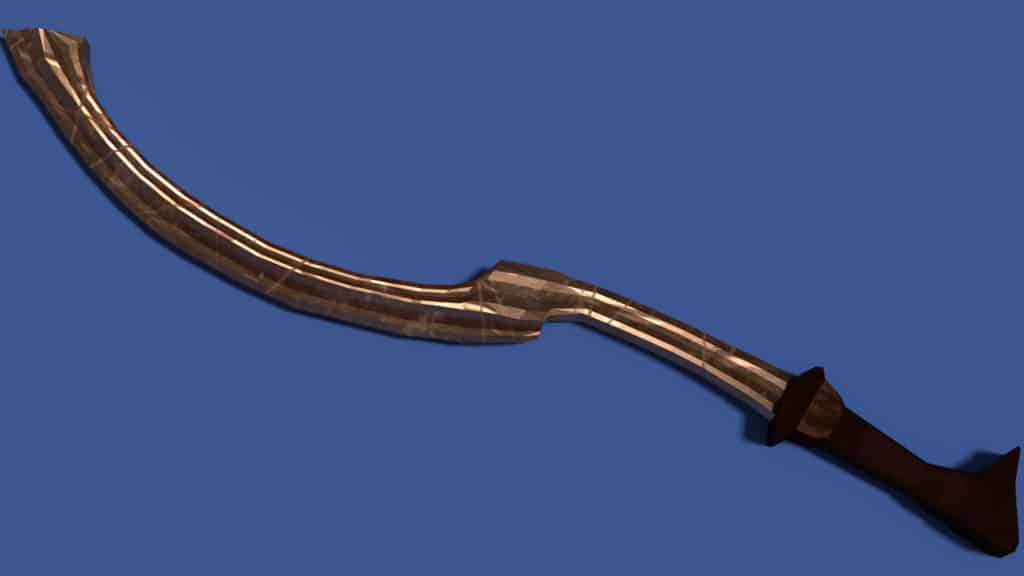
11. The khopesh – Egypt’s iconic sickle-sword for hooking, clubbing, and cutting foes apart
Long before Rome, Japan, or the Viking world took shape, the armies of ancient Egypt were experimenting with metal blades. By around 4,500 years ago, Egyptian warriors were arming themselves with swords that offered more reach and flexibility than axes alone. One of the most distinctive of these weapons was the khopesh, a sickle-shaped sword that looks like a cross between a cleaver and a question mark.
A typical khopesh is relatively short by later standards—roughly 50–60 centimeters in length—and curves forward, with the outer edge sharpened while the inner edge remains dull. The sharpened outer curve makes it a brutal slashing weapon, ideal for cutting at limbs, necks, or unprotected flanks. At the same time, the heavy spine and hooked shape allow the blade to function like a club or a tool for manipulating an enemy’s shield or weapon. A trained fighter could use the curve to catch a shield rim, yank it down or aside, and follow up instantly with a chop or cut.
In battle, such versatility mattered. Egyptian troops often fought in tight formations, so an officer or elite soldier with a khopesh could reach around a front-rank shield, hammer down with the blunt inner edge, or slice at exposed areas with the sharpened outside. It was as much a control tool as it was a killing blade, letting the user unbalance an opponent and create openings where none seemed to exist.
At some point around the late Bronze Age, straight swords and different tactics began to replace the khopesh as a standard battlefield weapon. Yet it never truly vanished from Egyptian culture. Pharaohs such as Tutankhamun were buried with khopesh swords; the boy-king’s tomb contained at least two. The weapon appears frequently in tomb paintings and reliefs, often in the hands of gods or rulers smiting their enemies. Even when no longer common on the battlefield, the khopesh continued to serve as a powerful emblem of royal authority and divine victory.
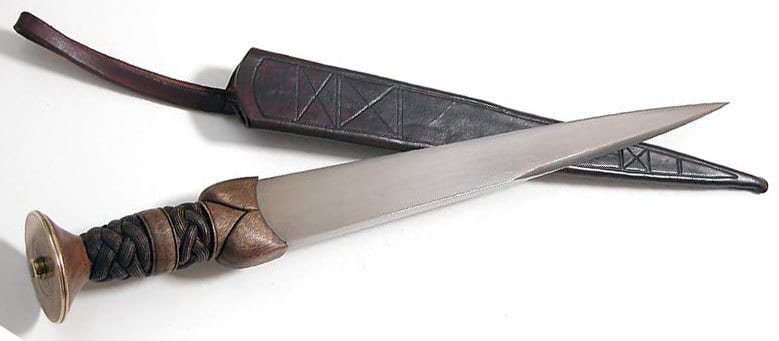
10. The Highland dirk – a long fighting dagger carried by Scots in war, peace, and oath-swearing
In the rugged Scottish Highlands of the 16th and 17th centuries, not every man could afford a full-sized sword. Steel was expensive, and a finely made broadsword was a serious investment. A long dagger, however, was within reach of many more people. The Highland dirk grew out of this reality and became an almost universal sidearm for fighting-age men in the region.
A traditional dirk is much longer than a typical modern knife, with a blade commonly around 10–12 inches and a handle shaped to fit the fist securely. It is primarily a thrusting weapon, but its length also allows for chopping strokes in close quarters. For Highland warriors, the dirk was the weapon you relied on when the battle line dissolved into grappling, when shields locked and bodies pressed together and there was no room to swing a sword. At that range, a quick, stabbing blade could decide who walked away.
During the many conflicts between Scots and English forces, the dirk earned a reputation for being brutally effective in hand-to-hand fighting. It could punch through basic armor, pierce between ribs, or slash at an opponent’s throat when the two men were almost chest-to-chest. Even wealthier Highlanders, who
could afford full swords, carried dirks alongside their other arms in both everyday life and on campaign.
Over time, the dirk also accumulated symbolic weight. It became part of Highland dress and ritual. Men used their dirks in ceremonial ways—cutting food, carving, or placing a hand on the blade when swearing a binding oath. The belief grew that if a man broke that oath, the spirits tied to the blade would punish him. After the Jacobite rising and the defeat at Culloden in 1746, British authorities tried to strip Highland culture of its warlike trappings and banned weapons such as the dirk. Ironically, this only reinforced the dagger’s status as a uniquely Scottish symbol of defiance and identity.
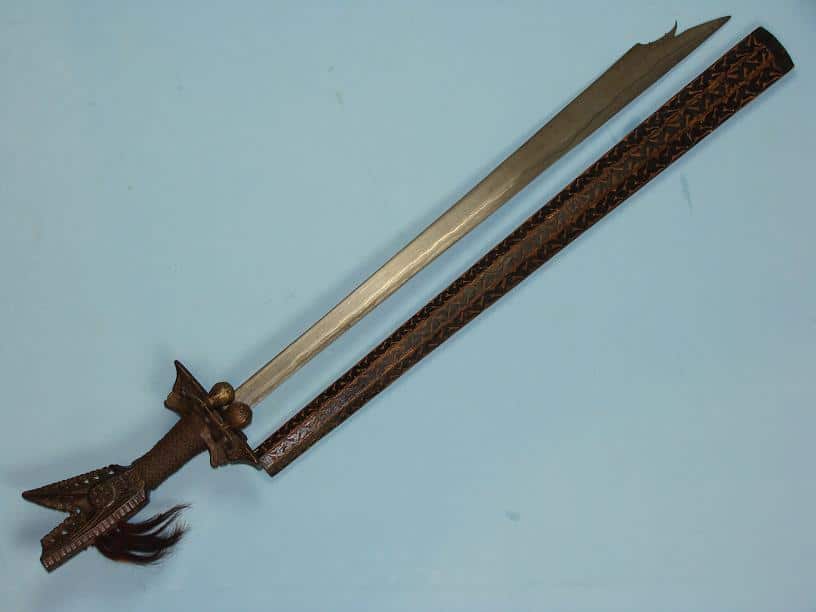
9. The kampilan – a fearsome double-tipped sword that helped bring down Magellan
In April 1521, the Portuguese navigator Ferdinand Magellan, sailing under the Spanish flag, clashed with the local ruler Datu Lapu-Lapu and his warriors in the Philippines. On the shores of Mactan, European armor and steel met indigenous weapons and tactics. Among the tools of the defenders was the kampilan, a long, single-edged sword with a strange and intimidating tip. Local accounts and later legends remember the kampilan as the weapon that cut Magellan down.
A kampilan typically has a straight or slightly widening blade around a meter long, with most of the weight concentrated toward the front. The handle is often made of carved wood, sometimes ornamented with hair or other decorations, and designed for a two-handed grip when needed. The most striking feature, though, is the bifurcated tip. Instead of narrowing to a simple point, the blade splits into a main tip and a smaller spike or horn, giving the impression of a gaping mouth or an open jaw.
This unusual design is more than just artistic flair. The reinforced, split tip creates a devastating stabbing profile. When driven into a body, it could produce large, ragged wounds that were extremely difficult to treat—especially in an era with virtually no surgical care. The kampilan could also be used to deliver heavy chopping blows, with the blade’s front-weighted mass turning each strike into a powerful cleaving action. In close-quarters melee, a warrior armed with such a sword could cut, thrust, and intimidate all at once.
To European soldiers accustomed to different sword shapes, the kampilan’s silhouette must have been unsettling. Facing an enemy who looked comfortable swinging these strange, double-tipped blades in their own terrain, Magellan and his men quickly found themselves overwhelmed. The Battle of Mactan ended with the famous explorer dead and his expedition shaken—an early reminder that unfamiliar local weapons could be every bit as deadly as European steel.
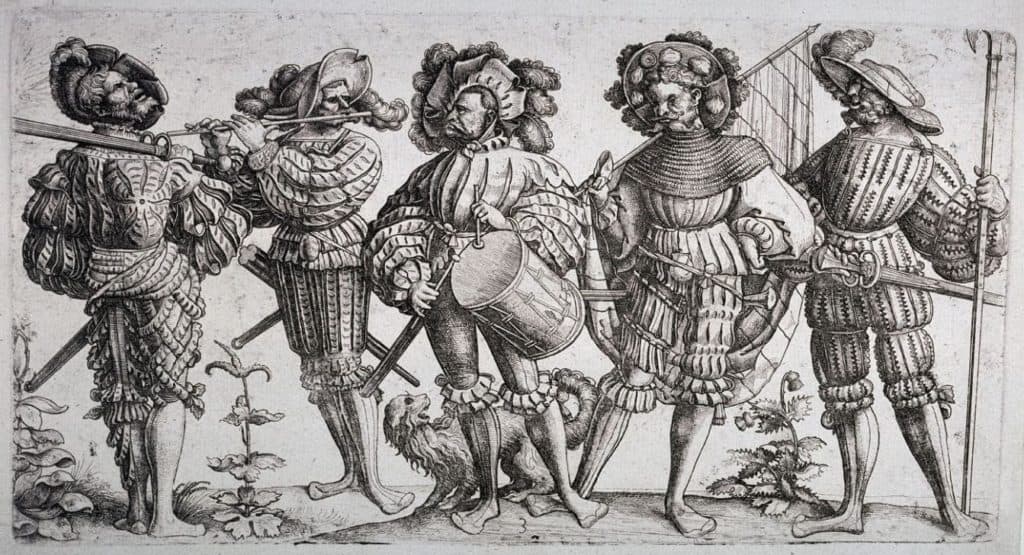
8. The katzbalger – a squat, rounded-tip sword for ruthless close-in slashing
During the Renaissance, German and Swiss mercenaries known as Landsknechte became some of the most sought-after soldiers in Europe. Armed with long pikes, halberds, and early firearms, they fought in dense blocks that could push through enemy lines or hold firm against cavalry. But when formations broke down and enemies rushed in under the pike points, these men needed something else. Their answer was the katzbalger, a compact, sturdy sword designed specifically for brutal, close-in work.
The katzbalger is easily recognizable. Its blade is relatively short—usually under a meter—straight, and double-edged, but with a distinctively rounded or spatulate tip instead of a sharp point. The hilt often features an S-shaped or figure-eight guard that curls back toward the blade. The unusual tip was not a sign of weakness; it was a deliberate choice. In the swirling chaos of a tight melee, thrusting could be dangerous. A pointed sword might stick in an enemy’s body or armor, leaving the wielder briefly disarmed. A rounded tip, on the other hand, made the katzbalger primarily a cutting and chopping weapon.
For a pikeman who suddenly found an enemy in his face, this sword was exactly what he needed. He could draw it quickly and start hacking at legs, arms, and unprotected areas while still tangled in a press of bodies. Many accounts suggest that soldiers would target the thighs and knees, chopping an opponent down and then finishing him once he fell. The lack of a sharp point meant fewer accidental impalements in the crush and easier recovery after each blow.
The name “katzbalger” has several possible origins—one popular explanation connects it to scabbards supposedly made from cat skin—but whatever the true etymology, the weapon’s reputation is clear. It was the trusted backup of elite mercenaries who were paid to stand in the most dangerous part of the battlefield. In that role, it earned a place on any list of history’s most practical and deadly sidearms.
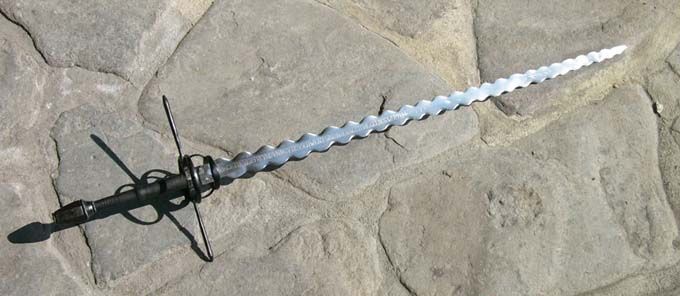
7. The flammard – a “flame-bladed” sword whose wavy edge made every clash more punishing
At first glance, the flammard (or flammenschwert in German) looks almost ornamental. Its blade ripples in a series of curves from hilt to point, giving the impression of a frozen flame. But this undulating design was not simply for show. In experienced hands, a flammard could change how blades interacted in a fight and influence both offense and defense in subtle ways.
The wavy profile affects the way the sword cuts and how it meets an opponent’s weapon. When a flammard’s edge slides along another blade, the waves create a series of small bumps and catches. This can slow or disrupt the other sword’s movement, making it a little harder for the opponent to glide smoothly into a counterattack. In the same way, when a flammard strikes flesh, the alternating narrow and wide sections tend to open up irregular wounds that can tear more severely as the blade is withdrawn.
Most flammard swords produced in Renaissance Europe were one-handed rapiers—long, relatively slender weapons carried by gentlemen, soldiers, and bodyguards for both dueling and battlefield use. These swords were light enough to wear daily but still deadly in an argument that turned violent. Fencers of the time debated the practical advantages of the wave, but many agreed that, at the very least, the visual effect could be intimidating, and the subtle drag on opposing blades offered a defensive benefit.
There were also rare two-handed flammards. These larger “great swords” combined a huge reach with the same rippling edge, turning each sweeping cut into a terrifying spectacle. Only particularly strong, well-trained soldiers could wield them effectively, often as specialists employed to disrupt enemy formations. Those who swung such swords typically demanded higher pay, and you can imagine why: few things on a battlefield would be more frightening than a towering fighter spinning a massive, flame-shaped blade through the air.
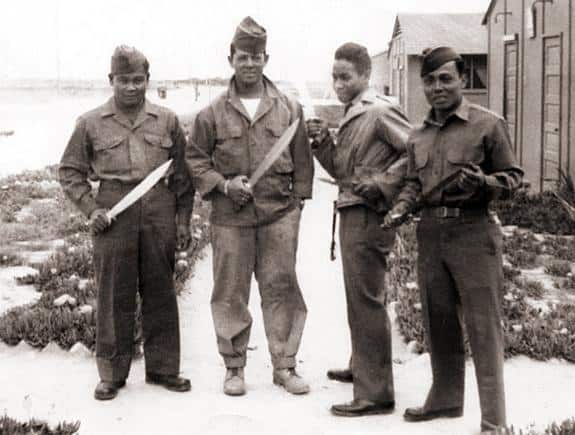
6. The bolo – a simple farm tool that became a terrifying guerrilla weapon
The bolo began life as a work knife. In the fields and jungles of the Philippines, people used it for clearing brush, chopping wood, harvesting crops, and general daily chores. Its blade is short, broad, and tough, with a weight-forward balance that makes it excellent for chopping through vegetation. That same balance, however, also makes it a formidable weapon when turned against human targets.
During the Philippine-American War (1899–1902), many local fighters lacked modern rifles or had limited ammunition. The bolo filled the gap. Guerrillas who knew the terrain slipped through jungle paths and villages, closing in quietly on isolated patrols or sentries. At very close range, a bolo thrust into the abdomen, neck, or ribs was fast, silent, and devastating. In the confusion of an ambush, fighters could disappear back into the landscape with their familiar tools in hand, leaving dead or wounded soldiers behind.
The bolo’s role did not end there. Decades later, during the Japanese occupation in the Second World War, Filipino resistance groups again drew their bolos from farm work and used them in combat. Units like the Moro-Bolo Battalions became notorious for their willingness to close with occupying soldiers in dense jungle, where bayonets and rifles were harder to maneuver and a heavy chopping blade had the advantage. The bolo’s simplicity meant that there was no shortage of weapons: almost every rural household had one.
The knife’s reputation even spread beyond the islands. Some American soldiers and scouts adopted bolo-style knives after their campaigns in the Philippines, appreciating the design’s toughness for both camp chores and emergencies. One famous example is Henry Johnson, a Black American soldier in World War I who resisted a night raid on his unit’s position in France. Armed only with a rifle and a bolo knife, he fought off multiple attackers. His actions eventually earned him a posthumous Medal of Honor, and the humble bolo became part of that story—proof that a tool of everyday life can become a deadly weapon in desperate hands.
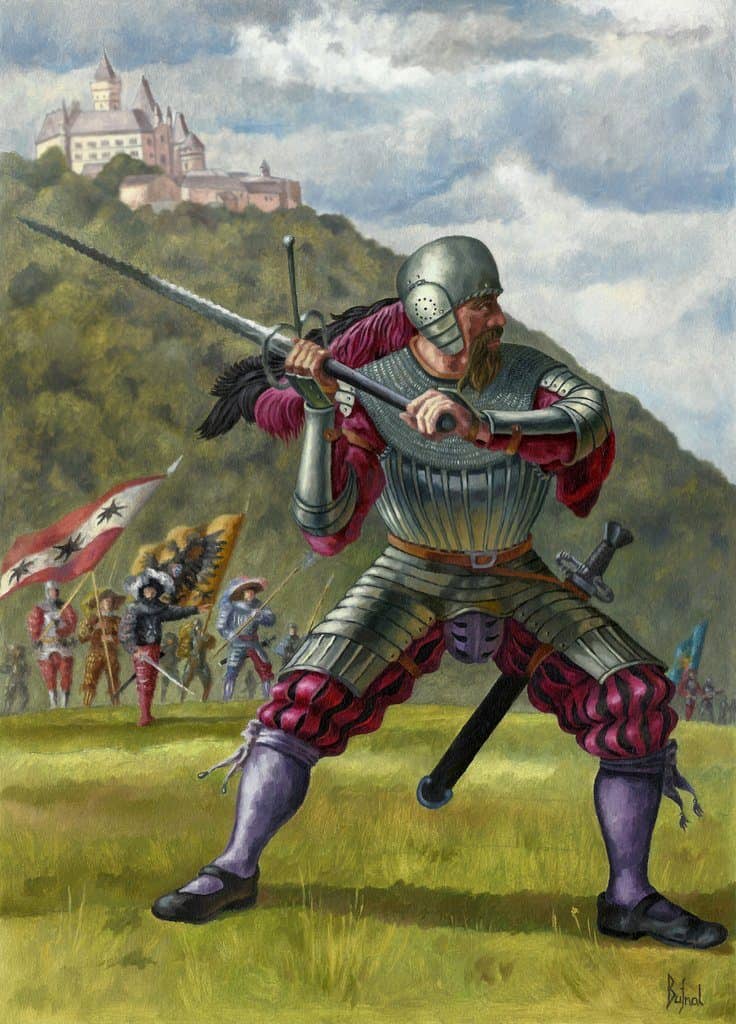
5. The zweihander – a colossal two-handed sword built to smash pikes and terrify foes
By the late 15th century, European warfare was dominated by dense blocks of pike-armed infantry. Long, bristling ranks of spears could stop cavalry and pin enemy formations in place. To break such walls, some soldiers turned to equally extreme weapons. The zweihander—literally “two-hander” in German—was one of the most dramatic answers: a sword so large that it blurred the line between sword and polearm.
Early zweihanders evolved from the longsword, stretching both blade and hilt to impressive lengths. Some examples exceed two meters (over six and a half feet) overall and weigh several kilograms. The long grip allowed the wielder to use both hands spaced widely apart, generating huge leverage. Many blades featured additional parrying hooks or lugs a short distance above the guard; these helped catch and control enemy pikes and also provided a place to half-sword—that is, to grip the blade itself for even finer maneuvering.
In battle, specialist soldiers armed with zweihanders were often deployed at the front or flanks of pike blocks. Their job was dangerous: stride into the forest of spear points and swing, chop, and beat aside the enemy’s weapons to open gaps for comrades to exploit. Stories from the period, especially about the German Landsknechte, describe men who could cut off multiple pike heads—or, in legend, multiple enemy heads—with a single massive swing. Whether or not the tales are embellished, there is no doubt these swords were fearsome to face.
Because handling such a weapon required strength, training, and nerve, zweihander-wielding mercenaries frequently received higher pay than ordinary infantry. Onlookers could spot them easily in their flamboyant clothing, towering blades resting on their shoulders. Over time, as firearms and different tactics reduced the need for such extreme melee weapons, zweihanders became more ceremonial, carried by guards and honor troops. But for a period in European history, they were the oversized answer to the problem of punching through the most tightly packed formations on the field.
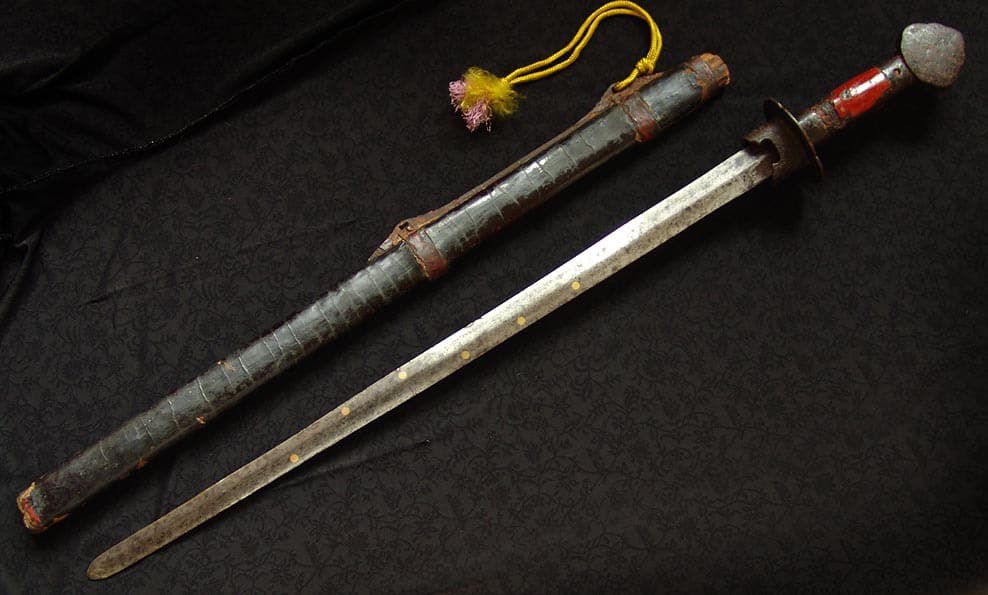
4. The jian – China’s “gentleman of weapons,” a straight sword for both cutting and thrusting
In Chinese tradition, different weapons are often given personalities. The spear might be called the “king of weapons,” while the straight, double-edged sword known as the jian is sometimes called the “gentleman of weapons.” This reflects both its elegance and the refined skills required to use it well. Unlike some heavy hacking swords, the jian rewards precision, timing, and controlled movement.
The jian has been around for at least 2,500 years. Archaeological finds show examples dating back to roughly 500 BC, and the basic shape has changed surprisingly little. A typical jian has a straight, double-edged blade, a simple guard, and a handle long enough for one or sometimes two hands. Although it looks straightforward, the blade is traditionally thought of in three sections, each with its own role: the tip for fine thrusting and delicate cuts, the middle for general offense and defense, and the lower portion nearer the guard for parrying and strong blocks.
On the battlefield, jian were carried by officers, elite bodyguards, and skilled fighters rather than massed infantry. They could be used to stab into gaps in armor or to deliver precise cuts to tendons and joints. At the same time, the sword’s balance made it suitable for rapid changes of direction, feints, and flowing movement rather than brute-force chopping. Over the centuries, entire systems of swordplay and internal martial arts developed around the jian, emphasizing posture, footwork, and a kind of relaxed power.
Legend and folklore are full of jian-wielding heroes and immortals, their swords often given names and near-mythical qualities. In reality, the weapon’s versatility is what made it endure for so long. It could thrust, slice, and parry with equal grace, bringing together offense and defense in a single, deceptively simple-looking package. Even today, in Chinese martial arts demonstrations and forms practice, the jian remains a symbol of cultured skill—proof that a truly deadly weapon does not have to look brutal to be effective.
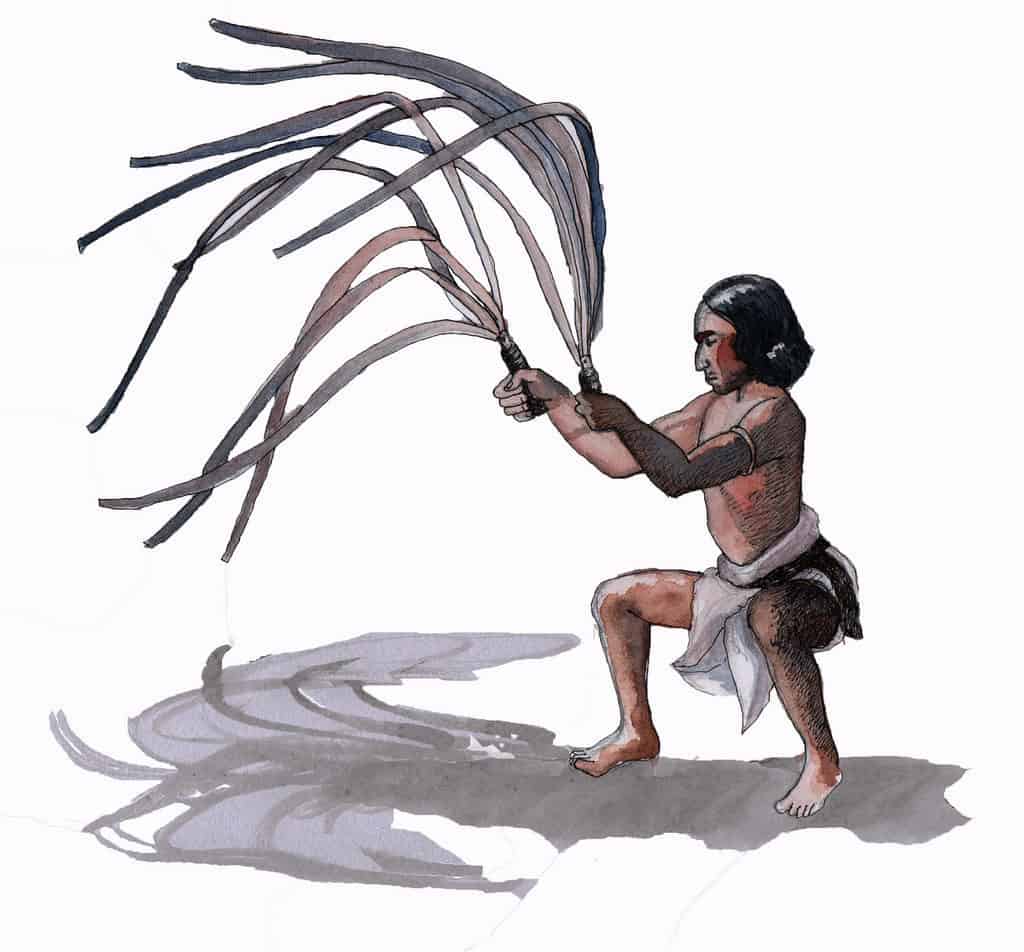
3. The urumi – a whip-like sword of flexible blades that could strike many foes at once
Among all the swords in history, few are as strange—or as dangerous to their wielder—as the urumi. Originating in southern India and parts of Sri Lanka, this weapon blurs the line between sword and whip. Instead of a single stiff blade, an urumi consists of several long, flexible metal strips attached to a common hilt. When not in use, the blades can be coiled around the waist like a belt; when deployed, they transform into a whirling storm of steel.
Historical sources suggest that versions of the urumi may have appeared as far back as the early centuries AD, perhaps during the Sangam period. Designs vary, but many examples feature multiple blades, each as long as or longer than a person’s arm, only a few centimeters wide, and sharpened along the edges. The handle is usually sturdy, sometimes with a protective guard, because the user’s grip is essentially the only solid anchor point on an otherwise flexible weapon.
Using an urumi safely requires immense training. A fighter must be comfortable with both swords and whips before even attempting to learn it. Without precise control over distance, timing, and body rotation, the blades can snap back and cut the wielder or his allies. But in skilled hands, the urumi becomes a terrifying area-denial weapon. By spinning, twisting, and stepping, the fighter can keep multiple opponents at bay, lashing the flexible blades in wide circles or sudden flicks that wrap around shields and limbs. Armor that works well against rigid blades may be less effective when thin strips of steel whip around edges or catch exposed skin from unexpected angles.
Traditional stories describe fighters wielding an urumi in each hand, turning themselves into moving centers of danger. In more formalized martial arts practice today, the weapon is still used in demonstrations, often with one practitioner facing several opponents armed with shields or sticks. In an era dominated by rigid swords and spears, the urumi stands out as a bold experiment—hugely risky, extraordinarily difficult to master, and devastating when used by someone who truly understood it.
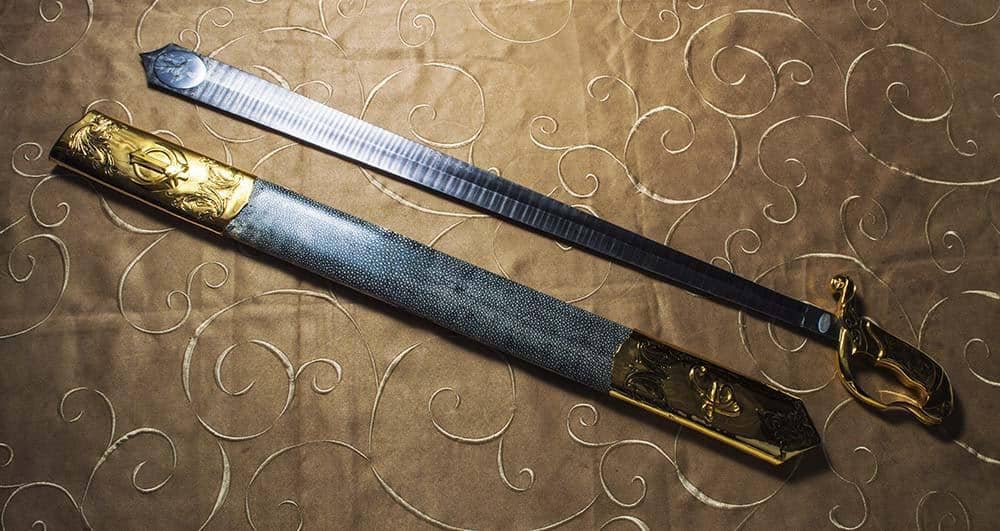
2. The khanda – a straight-edged Indian sword that became both a battlefield and spiritual icon
Across the Indian subcontinent, the khanda developed into one of the most recognizable local sword forms. It likely emerged in its early versions during the Gupta period (around the 4th to 6th centuries AD) and evolved over many generations of warriors and smiths. At first glance it looks relatively simple: a straight, broad, double-edged blade with a blunt or squared-off tip. But that blunt tip is intentional, and it reveals how the khanda was meant to be used.
Unlike many European swords, which balance cutting and thrusting, the khanda is built almost entirely for chopping and slicing. The edges are sharpened, but the top is not, so stabbing is limited. Many blades have a reinforced spine or central ridge to stiffen them and add cutting power. Combined with a hilt that often includes a knuckle guard, finger ring, or even a basket hilt in later centuries, the sword is meant to be driven with commitment into an enemy’s body. In close formations or personal combat, an unhorsed warrior could swing a khanda with both hands and carve vicious paths through lightly armored foes.
From the 18th century onward, European contact influenced the look of some khanda hilts, but the weapon’s core shape remained recognizably Indian. At the same time, its cultural significance deepened. In Sikh tradition, the khanda came to represent divine knowledge, justice, and sacrifice. The image of a double-edged sword stands at the center of the Sikh emblem, symbolizing the power to cut through untruth and uphold moral duty. For Rajput warriors and other martial communities, the khanda also became linked with heroic last stands. Legends tell of fighters encircled by enemies who would grip the sword with both hands, lift it overhead, and chop straight down, trying to strike as many opponents as possible in a final act of defiance.
Because of these associations, many khanda swords were elaborately decorated. Blades might bear inscriptions, gold inlay, or religious symbols; hilts could be wrapped and ornamented to reflect the owner’s status. Thus, the khanda exists at a crossroads between tool of war and sacred object. It served on campaign, but it also appeared in ceremonies, rituals, and temple iconography, its blunt-tipped silhouette instantly recognizable.
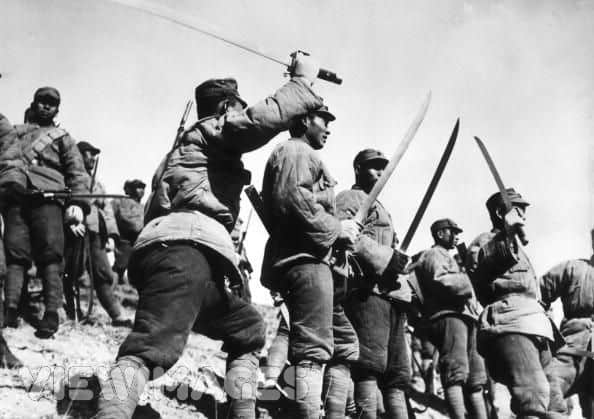
1. The Miao Dao – a long Chinese saber still carried into battle in the 20th century
When people think of swords in the Second World War, they often picture Japanese officers with their katana-style blades. Less well known outside East Asia is that some Chinese troops also went into that modern conflict carrying traditional long swords. One of the most notable of these was the Miao Dao, a large, slightly curved saber that combined elements of older Chinese and foreign designs.
The name “Miao Dao” is often translated as “sprout saber” because its outline resembles a sprouting plant: a long, gently arcing blade growing from a relatively short hilt. A typical example might be around 55 inches overall, with roughly 38 inches of that being blade. The curve is not as pronounced as some sabers, but it is enough to aid in cutting while still allowing effective thrusts. The handle usually accommodates two hands, and the balance lets a strong fighter wield it either with both hands for maximum power or one-handed when necessary.
Historically, similar long sabers appear in Chinese sources as early as the Ming dynasty, used to counter cavalry and to slice through ranks of lightly armored soldiers. Training methods emphasized wide, stepping cuts, rapid changes of direction, and the ability to deal with multiple opponents. The sword’s length allowed users to keep enemies at a distance while still hitting with serious force; in close quarters, the curve and weight made it a frightening chopping weapon.
In the brutal fighting of the Second Sino-Japanese War (1937–1945), some Chinese units revived or retained these long sabers. In desperate close-quarters situations—trench raids, ambushes, and night attacks—rifles and machine guns could become unwieldy, and bayonets were not always ideal. A Miao Dao in trained hands could deliver decisive blows in cramped, chaotic environments. Contemporary accounts and photographs show soldiers carrying these swords, and reports describe their use not only in combat but also in grim tasks such as executing prisoners by decapitation.
By the mid-20th century, of course, firearms had thoroughly eclipsed swords as primary weapons of war. Yet the very fact that the Miao Dao still appeared on modern battlefields says something about how effective and respected it was. Long after most cultures retired their great blades to museums and ceremonies, this Chinese saber continued to be swung in earnest, closing a long historical arc that began with bronze and iron and ended amid barbed wire and artillery.




